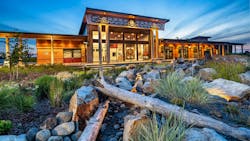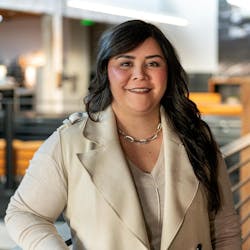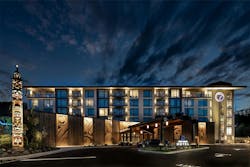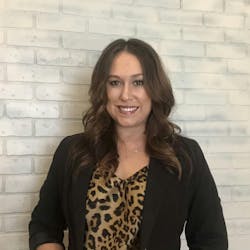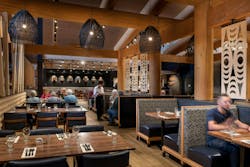How Rice Fergus Miller Creates Culturally Rooted Hospitality Spaces
At the 2025 Washington Indian Gaming Association’s (WIGA’s) Northwest Indian Gaming Conference & Expo, hospitality floorcovering manufacturer Encore and Rice Fergus Miller shared more than a booth. We shared a vision for intentional, community-centered design.
Rice Fergus Miller, Inc, a Bremerton, Washington–based architecture and interiors firm, is known for their thoughtful work across tribal hospitality, healthcare, and senior living environments. They design with purpose, prioritize people, and approach each space as a living story.
To highlight the values our organizations share, including collaboration over ego, excellence rooted in empathy, and design that reflects identity, I sat down with Jennifer Fleming, Interior Designer and Principal at RFM, for a discussion about how community and connection are prioritized in meaningful interior design projects.
Conversations like this remind me that great design doesn’t happen in isolation. It’s built on trust, shared purpose, and a willingness to listen first.—A.L.
Allison Lampo: Your work spans hospitality, healthcare, and senior living. These are all spaces that hold deep emotional and cultural significance. How do you begin the process of designing for that kind of human connection?
Jennifer Fleming: We start by listening. The notion there is a one-size-fits-all solution for any project is missing an opportunity to tailor how they work to fit the client or organization. By listening first, we connect to the community we are working with and develop the “big idea” or story for our projects together. When we understand the lived experiences, values, and vision of the people who will use and care for these spaces, we can begin to design environments that support healing, gathering, celebration, and rest—whatever the need may be. These projects aren’t about checking boxes—they’re about honoring identity and building community.
AL: At Rice Fergus Miller, your team is known for designs that honor place and people. When you’re working on a tribal project, how do you ensure the design reflects the community it serves—not just aesthetically but with authenticity?
JF: Authenticity comes from relationships. We don’t show up with a predetermined aesthetic or impose a style—we show up to learn. We spend time listening to stories, understanding the landscape, and meeting with Elders, leaders, and staff . From there, we begin to design environments that are shaped by those lived experiences and cultural priorities. Whether it’s a health clinic or a hotel lobby, the goal is to design something that feels like it could only exist in that place, for that community. That’s where meaning lives.
Our work isn’t about replicating design standards—it’s about creating unique solutions that are deeply connected to the people we’re designing with. We believe the best projects are those that couldn’t be picked up and dropped somewhere else—they belong to the land and the culture they serve.
A big part of that is knowing when to step back and make space for others to lead. We’re not here to interpret or create cultural artwork ourselves. Instead, we focus on connecting tribal artists and artisans directly to product manufacturers—whether it’s for custom carpet, wall finishes, or other integrated design elements. That ensures the stories being told in the space are coming from within the community, not being filtered through an outside lens. When artists are empowered to shape the visual language of a project, the result is not only beautiful—it’s authentic, lasting, and deeply rooted.
AL: Encore is proud to have provided the flooring for your WIGA Northwest Indian Gaming Conference & Expo booth this year. In your eyes, what does a strong partnership between designer and manufacturer look like, especially when you’re trying to execute a shared vision under tight timelines?
JF: The strongest partnerships are built on trust along with shared vision and goals. When we collaborate with manufacturers like Encore, we’re looking for more than just product—we’re looking for partners who understand the vision and bring creative, timely solutions to support it. That’s especially critical on so many of our projects, where timelines are often tied to funding cycles or economic opportunity windows. A good partner understands those pressures, communicates openly, and is willing to go the extra mile to make the design a reality without compromising quality.
Editor's Picks
AL: So many hospitality spaces lean into sameness. How do you and your team keep pushing for originality and meaning in environments that are often under pressure to play it safe?
JF: There’s a difference between designing something familiar and designing something forgettable. Too often, hospitality plays it safe by repeating what’s already been done—but in doing so, it loses the opportunity to foster real connection. We approach every project—whether it’s a casino, luxury RV resort, or an urban boutique hotel—with the belief that it should reflect the identity of its place and the people behind it.
True originality is rooted in authenticity. It comes from listening closely and understanding what matters most to the client—its values, its stories, its land. In our Tribal hospitality work, that might mean collaborating with local artists, integrating traditional patterns, or drawing on the natural landscape to inform materials and form. These aren’t just design choices—they’re decisions that create emotional resonance.
When guests feel that sense of connection—to the place, to the people, and to the story behind the space—it becomes more than just a stay. It becomes a meaningful experience. And that’s what we’re always striving for: hospitality that doesn’t just look different, but feels deeply connected and unforgettable.
AL: Looking back on your work with tribal communities, is there a project or partnership that stands out as especially meaningful; one that’s shaped your approach or affirmed why this work matters?
JF: 2025 marks 20 years of serving the Jamestown S’Klallam Tribe under the leadership of Chairman Ron Allen and CEO Jerry Allen. Our work with them was the catalyst to the development of our hospitality market at RFM and now our work has expanded to include housing and healthcare as well. The trust and partnership we have is deeply rooted in this journey we have been on as a company to grow our reach and impact with Indigenous communities. We would not be where we are today without their support. To grow with a client the way we have, to understand the vision Chairman Allen has for both the Tribe and their enterprise diversification, and to help bring those dreams to life is some of the most fulfilling work that I have personally done in my career.
*Republished with permission; post originally appeared in Allison Lampo’s newsletter “From the Ground Up,” June 25, 2025.
About the Author
Allison Lampo
A Seneca woman and longtime leader in the commercial flooring industry, Allison Lampo brings over a decade of experience partnering with tribal communities to shape spaces that reflect heritage, identity, and intention. As Vice President of Gaming at Encore, she specializes in tribal gaming and hospitality environments, guiding clients through complex flooring decisions with strategy, empathy, and cultural clarity.
Lampo leads with respect for legacy and a clear belief that cultural representation should never be an afterthought. When she steps into a space, she’s not just advocating for great design. She’s protecting tribal vision. To her, every layer matters.
